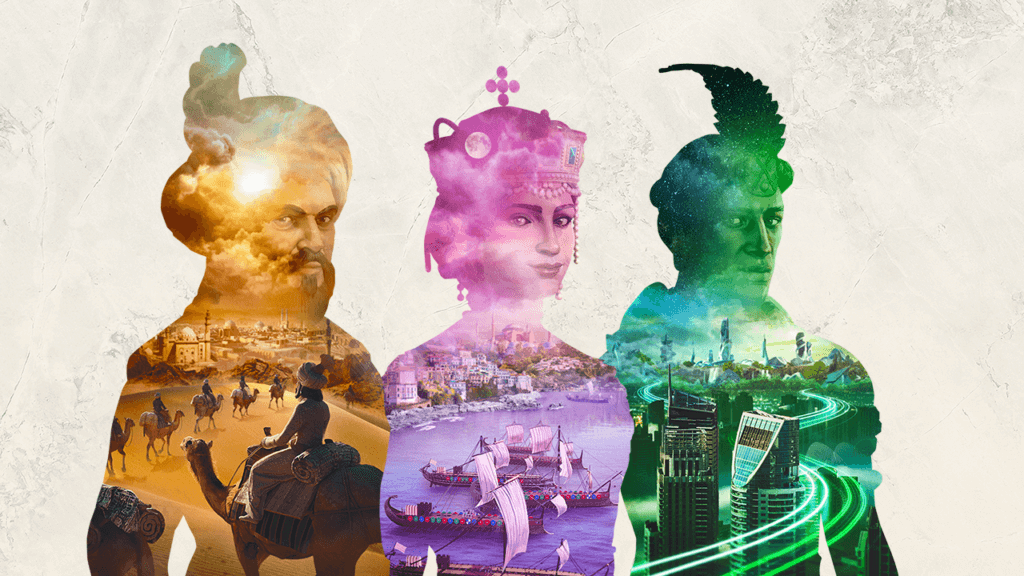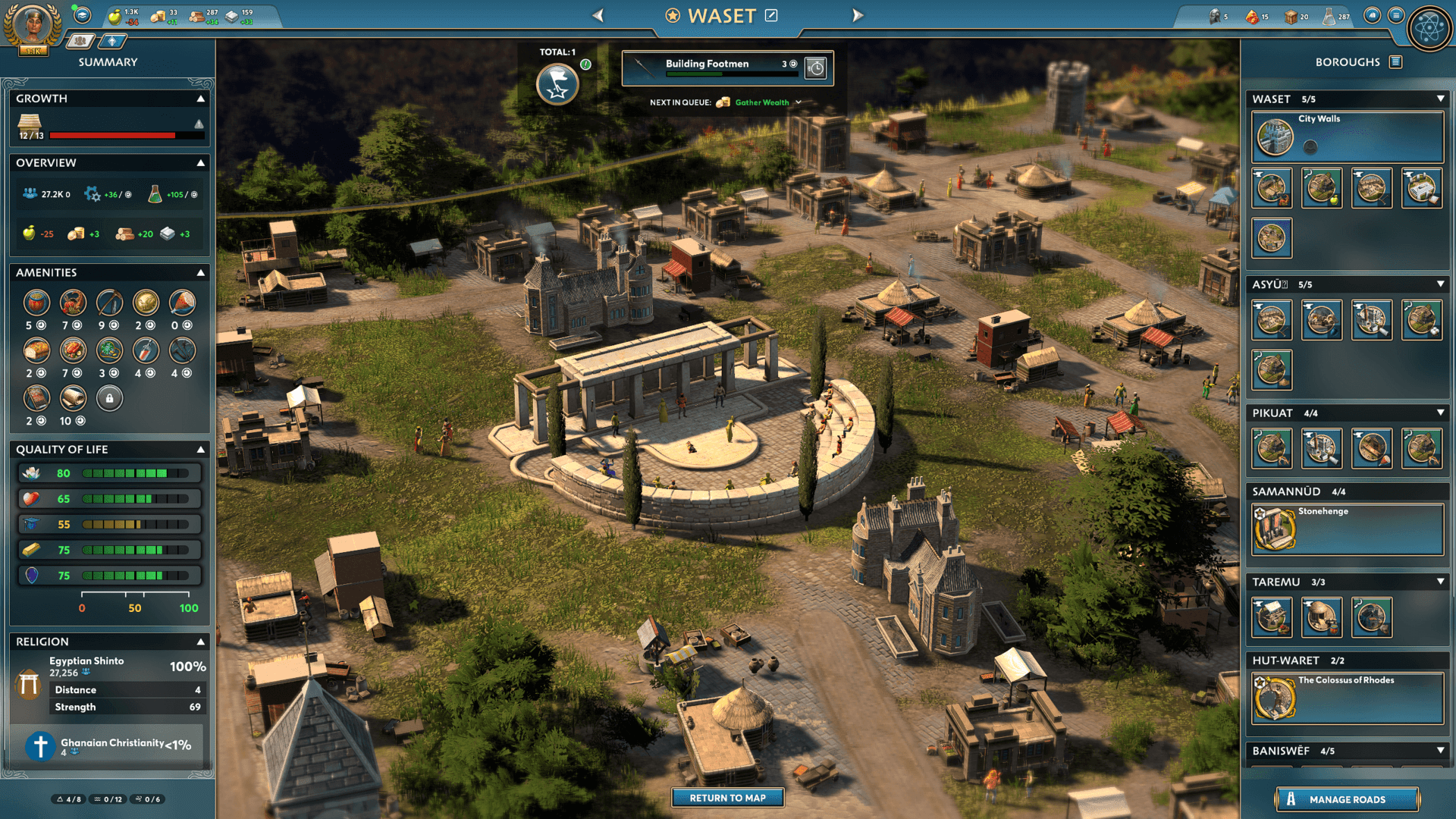It seems like most genres of video games have at least one monolithic title or series by which all others are judged. It’s hard to find a hero shooter that hasn’t been compared to Overwatch or a monster collector that doesn’t invoke memories of playing Pokémon(or the wrath of The Pokémon Company’s lawyers, whichever comes first). The 4X Strategy genre’s monolith is undoubtedly Sid Meier’s Civilization, even more so when discussing strategy games themed around history. I got into the genre through Civilization, my bachelor’s degree in history can probably tell you why, but eventually I started wanting to explore similar games in the same genre. As luck would have it, a team of developers who worked on Civilization V have created a brand new history based 4X Strategy game which I hoped would scratch that itch I’ve been having for a while.

All screenshots take from the game’s press kit and digital storefronts
Ara: History Untold is the latest in an ever expanding list of games looking to take a piece of the Civilization pie including titles like Humankind, Old World, and Millennia. Why start with Ara specifically? Well aside from being the most recent release, my mixed feelings on the recently revealed Civilization VII finally gave me the courage I needed to start seeking out the alternatives. Before we begin however, I would like to mention that I am a casual 4X player so don’t expect a masterful breakdown of the game mechanics because that would require hundreds of hours of playtime which I do not have.
Upon starting a game of Ara you’ll be met with a map composed of amorphous tiles, an obvious departure from the square and hexagonal tiles found in similar games. Furthermore each tile is subdivided into various plots where improvements can be built, so for example you could have an altar, a farm, and a workshop all on the same tile. I can definitely see the vision in this design choice since in real life most nations don’t have perfectly geometric borders, but in the context of a video game it creates a lot of visual clutter that can be hard to navigate. On that note, the user interface is generally pretty bad with overcrowded menus that can make it difficult to find what you’re looking for.
Ara also deviates from more traditional 4X games by borrowing features commonly associated with grand strategy games, namely the randomly occurring narrative events. Narrative events provide the player with an anecdotal story and a related decision to make in response. Depending on the player’s choice they can receive resources, temporary bonuses, or improved relations with neighboring factions, but each choice usually comes with similar trade-offs like expending resources or hurting foreign relations. While the impact of narrative events on the game is somewhat limited, I still feel they’re a fun inclusion that I want to see more 4X strategy games iterate upon.
What will make or break a game of Ara is the in-depth crafting system. By constructing workshops and similar improvements the player can craft items used to build more advanced buildings, units, and items. Alternatively you could also slot these items back into your various workshops to make future productions more efficient. This crafting system will delight players who prefer an emphasis on economy and city management in their 4X games, but it comes with a lot of micromanagement that will very quickly turn off anyone who doesn’t fall into that specific demographic(myself included). In fact the micromanagement was so bad during the game’s launch that the devs had to patch in new features that helped streamlined the game’s economy.

It’s cool that you can see citizens living and working in your cities when you zoom in, but the effort to make that happen probably should have gone elsewhere.
Ara also heavily skews the game towards crafting and economics by artificially limiting other aspects of the 4X genre. Combat for example is limited by the number of troops you are allowed to deploy at any given time and conquering other nations is limited by the fact that you can only control so many cities before your empire is hit with penalties. Combat was so bad at the game’s launch that in the same update as the economic streamlining they had to add the ability to upgrade technologically obsolete units and add strength modifiers based on terrain. I was also disappointed to find that religion largely exists as a half-baked supplement to other mechanics rather than being a fleshed out feature in its own right. Ultimately the only way to truly rack up those victory points and avoid being eliminated is to leverage your economy to craft items that will allow you to construct Triumphs, architectural wonders based on real places like Stonehenge, which usually nets you at least 100 or more victory points a pop.
The final aspect of gameplay I feel is worth covering are the leaders and paragons. Leaders are historical figures that act as the face of your nation and provide special mechanical bonuses based on their historical achievements. Mechanically speaking the leader imbalance is pretty rough as some leaders will have negative traits to compensate for their strengths while others provide nothing but benefits. I’m also not a fan of Ara locking important historical figures like Charlemange and Genghis Khan behind the game’s deluxe edition, but scummy DLC practices are a minor issue compared to Ara’s other flaws. Paragons are also historical figures, but they are recruited to your nation over the course of the game and provide bonuses based on their assigned archetype. Paragons, like many other aspects of the game, suffer from Ara’s bias towards crafting and economy focused strategies so recruiting paragons that increase production rates like engineers is pretty much always the best option.
Beyond mechanics, I would also like to comment on the selection of leaders because it takes a very similar approach as the upcoming Civilization VII. While Ara definitely includes its fair share of well-known heads-of-state that we typically see in these kinds of games, it also makes a conscious effort to expand the definition of “leader” to influential activists, artists, saints, scientists, and warriors. While it is fun to include more deep cuts among the famous faces, in some instances it cuts so deep that it begins to feel like wasted potential. I know I’m not alone in this sentiment as I’ve seen several posts on message forums from Argentinian players who have been waiting years for their country to be represented in a big 4X game complaining about 20th century actress/politician Eva Peron being chosen as a leader when they would prefer a national hero like Jose de San Martin.
The inclusion of paragons further exacerbates the leader problem by raising the obvious question: if the criteria for who gets to be a leader is so broad, who’s to say the paragons don’t also deserve to be leaders as well? For example, by what metric was Sappho chosen to lead Greece over someone like Aristotle or Homer? I’m not saying every paragon is worthy of the leader position, but it does highlight how limiting leaders to heads-of-state in previous 4X history games did have its advantages.
Then there’s the matter of Ara’s depiction of history which doesn’t really come up during typical gameplay as the subjects depicted are more or less just interchangeable pieces on a game board. That being said, there is an in-game encyclopedia called the encarta where players can read more about the various leaders, paragons, nations, government types, triumphs, and works of art featured in Ara. Well to put it bluntly, the encarta is bad. My main problem is that the encarta’s articles are way too short. Major elements of the game like leaders and nations average about 5 paragraphs per article with minor elements like paragons and technologies are only afforded 2 to 3 sentences. I can understand wanting to make each article digestible in a short amount of time for a casual audience, but even at their longest these articles leave out so much important information that nobody is going to learn anything meaningful from them.
Another feature of the encarta I find troubling is the brazen lack of political neutrality with many articles reading like Marxist propaganda. For example, the article on Communism paints an incredibly glowing picture of the ideology and refuses to acknowledge the countless atrocities committed under communist regimes throughout history. This becomes especially apparent when compared to the article on Fascism, which does acknowledge the atrocities of fascist regimes, but is so broad in its definition of Fascism that the core of the ideology is completely lost. Additionally, the encarta has a tendency to frame historical conflicts in terms of class struggle when the truth is far more complicated. For instance, the encarta wants you to believe that the French Revolution was simply a uprising of oppressed peasants against an oppressive elite, but the reality is that the French Revolution was actually new elites(academics and merchants) overthrowing old elites(nobles and clergy) with peasants on both sides of the conflict.
In regards to Catholicism, the encarta tries to avoid the subject as much as possible and when it’s unavoidable it will use as many euphemisms as possible to avoid explicitly religious language. The game uses the secularized BCE and CE for dates rather than the standard BC and AD despite the fact that it’s still based on the Gregorian calendar. God and Jesus Christ seem to be excluded from all conversation whenever possible and replaced by vague notions of faith, spirituality, destiny, and divine inspiration. I can’t go over every piece of Christian history included in the encarta because frankly that’s too big a task for a single man, but I will go over a few leaders and paragons that I feel were handled the worst.

St. Joan of Arc is my favorite leader to play as in Ara, but frankly I’m not sure this game deserves to have her in the first place.
Among the game’s playable leaders, Spanish leader Queen Isabella I of Castile is easily the most slandered by the encarta. The article claims Queen Isabella initiated the Spanish Inquisition primarily as a means of expelling Muslims and Jews from Spain. This is blatantly false because an inquisition by definition is a self policing body instituted to combat heresy within the Catholic Church itself. The only Muslims and Jews that would have been targeted by the inquisition would’ve been converts to Catholicism professing heretical beliefs. Another leader with a pretty misleading encarta article is Polish astronomer and Catholic canon Nicolaus Copernicus. The article claims Copernicus’s posthumously published magnum opus De Revolutionibus Orbium Coelestium was rejected as nonsensical or heretical in the 16th century because people were simply too stupid to understand it. Aside from the fact that the encarta clearly wants to portray the Catholic Church as anti-science(which is both historically and presently untrue) this is just petty, playground-level insults that no one in their right mind is going to take seriously.
On the subject of Paragons the encarta is even worse than leaders because they are only afforded 2 to 3 sentences each. When important information is left out, or if an irrelevant bit of trivia is left in, it sticks out like a sore thumb. An example of the former is Gregor Mendel, who is rightfully credited as the father of modern genetics, but omits the fact that he was an Augustinian abbot who conducted his experiments on plants within the garden of his monastery. In regards to the latter issue, St. Paul the Apostle is credited as being a tentmaker before his conversion to Christianity which I suppose is an interesting bit of information, but is completely irrelevant compared to the fact that he was one of the greatest persecutors of the early church pre-conversion which the encarta bafflingly ignores. Then there are articles that straight up don’t make any sense like the one on St. Thomas Aquinas which not only forgets to mention he was a Dominican friar, but is worded in such a way to make it sound like he wasn’t even Catholic!
I could talk endlessly about all the paragons that the encarta butchers, but there is one relatively obscure Catholic figure I feel particularly compelled to defend before capping off the discussion. Skanderbeg is strategist-type paragon the encarta claims revolted against the Ottoman empire due to the injustices the Ottomans inflicted upon their own people and vaguely citing “personal reasons” as secondary concerns. Since Skanderbeg is not well known among general audiences, let’s dive deeper into Skanderbeg’s history to show why his “personal reasons” were anything but secondary. Skanderbeg was an Albanian noble born in 1405 who was handed over to the Ottoman Empire as a hostage and raised to be a Janissary, a slave soldier indoctrinated into Islam to ensure his loyalty to the empire. Skanderbeg never lost the memory of his homeland and true religion while he was rising through the Ottoman ranks, biding his time for the right moment to return to his people. When he finally defected he led a massive military campaign against his former captors that brought any plans for Ottoman expansion into Europe to a screeching halt. While I have no doubt Skanderbeg witnessed many injustices during his time as a Janissary, his “personal reasons” of returning to his people and defending Christendom against the armies Islam are what truly makes him a legendary figure alongside other Catholic freedom fighters of his time like John Hunyadi and Vlad the Impaler.
Ara: History Untold is a game with a lot of potential, but the terrible user interface, copious amounts of micromanagement, and de-emphasising of mechanics I personally enjoy from other 4X strategy games killed my enthusiasm very quickly. While the post launch updates have taken steps to improve these issues it only serves to highlight that the game probably should have spent more time in beta-testing before being released. The absolutely insulting portrayal of history through the encarta also drained most of my motivation to keep playing the game or trying to enjoy it on its own terms. Ultimately Ara: History Untold is a game I can’t recommend unless you’re a diehard 4X gamer that enjoys economic strategies specifically. I suppose my search for an alternative to Civilization has only just begun. Maybe it’s time to start looking into science fiction and fantasy themed 4X games.
Scoring: 50%
Gameplay: 2/5
Visuals: 3/5
Sound: 3/5
Replayability: 2/5
Morality/Parental Warnings
Violence: Players have the option to view a cinematic recap of the battles they fight. These simulations aren’t very graphic as units mostly just shoot/swing their weapons at each other until one side falls over.
Sex: The cast of playable leaders are all dressed fairly modestly. One of the leaders, Osh-Tisch of the Crow Nation, is a biological male the game categorizes as a woman.
Religion: The game provides a premade list of religions the player can select for their nation including Christianity, Judaism, Islam, Shinto, Hinduism, Buddhism, Sikhism, Hellenism, Asatru, Isese, Jainism, Vedism, Romuva, Atenism, Tengrism, Baha’i, Wicca, Muism, and Vodou.
Ideology: The game’s history encyclopedia is extremely biased and at times down right propagandistic with plenty of articles promoting dangerous ideologies like Marxism. On the subject of Catholicism and Christianity it can be dismissive at best and hostile at worst.
